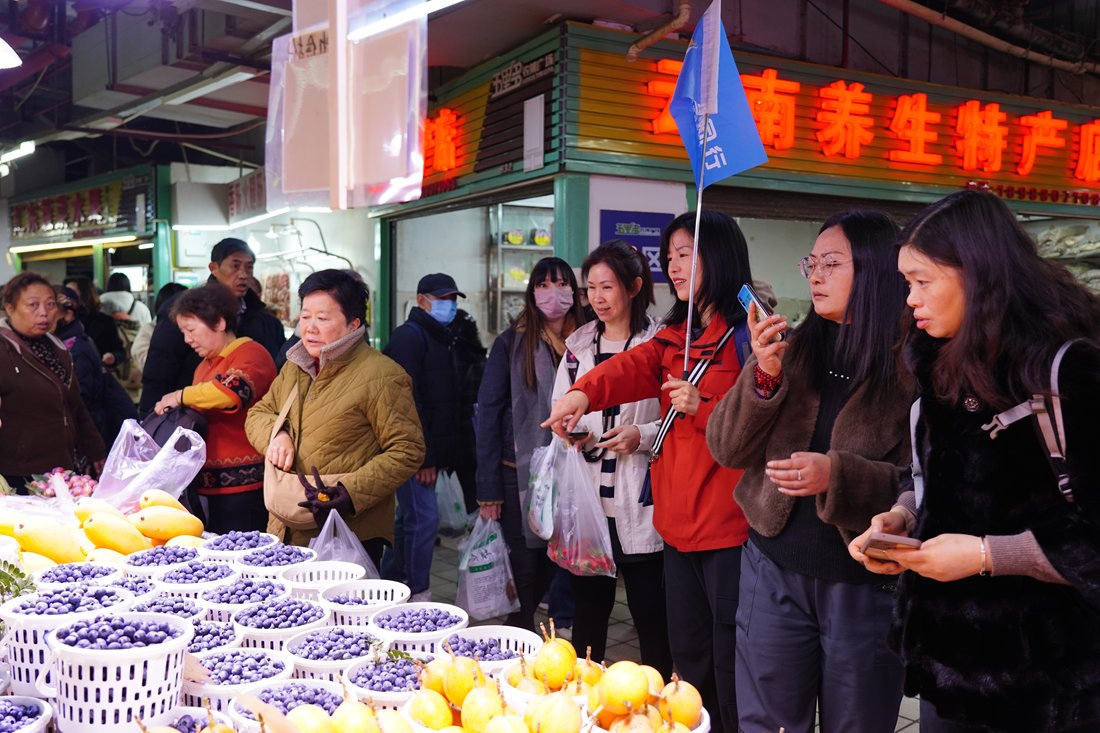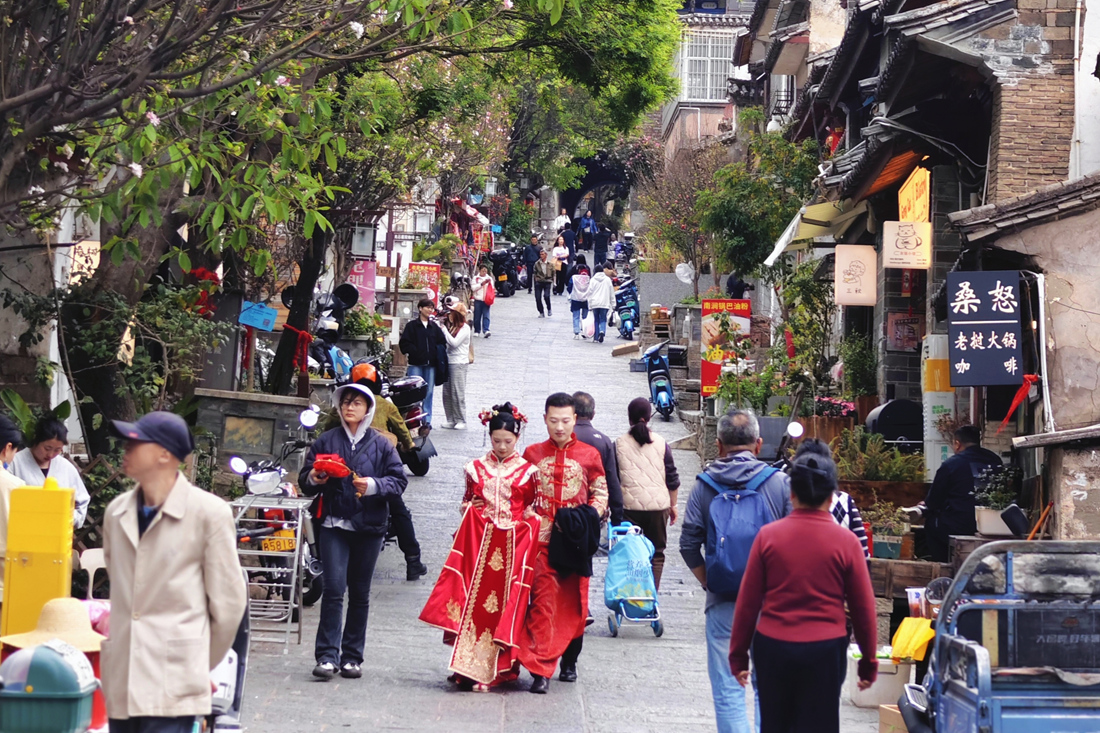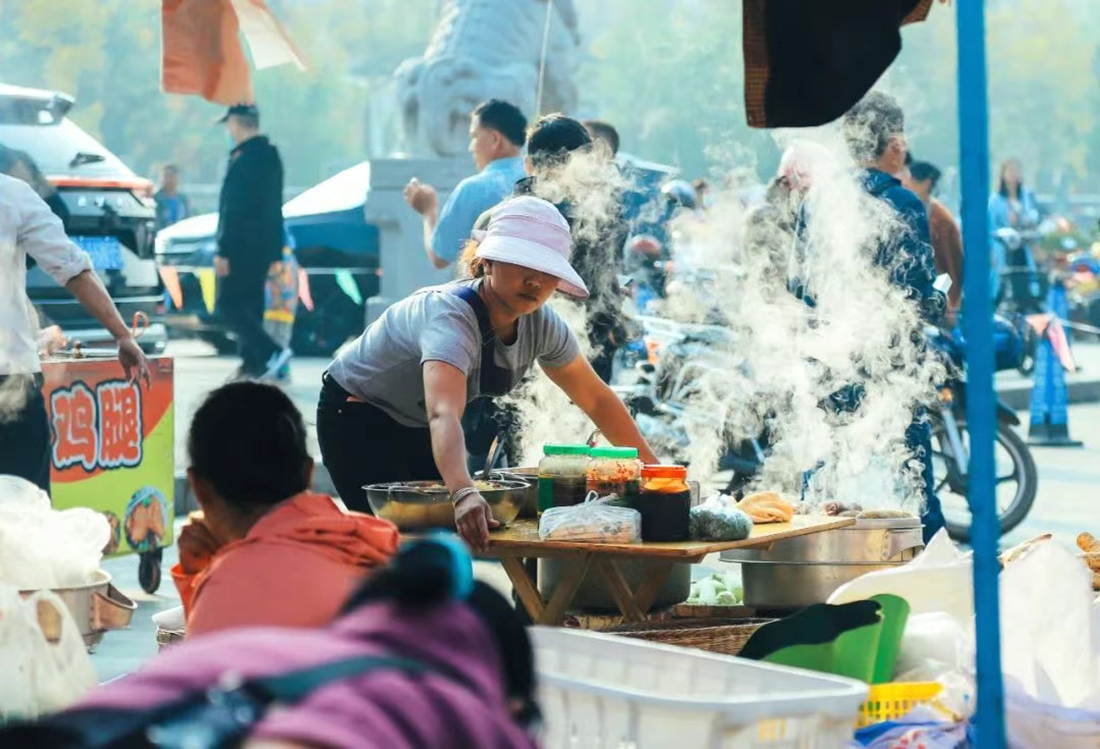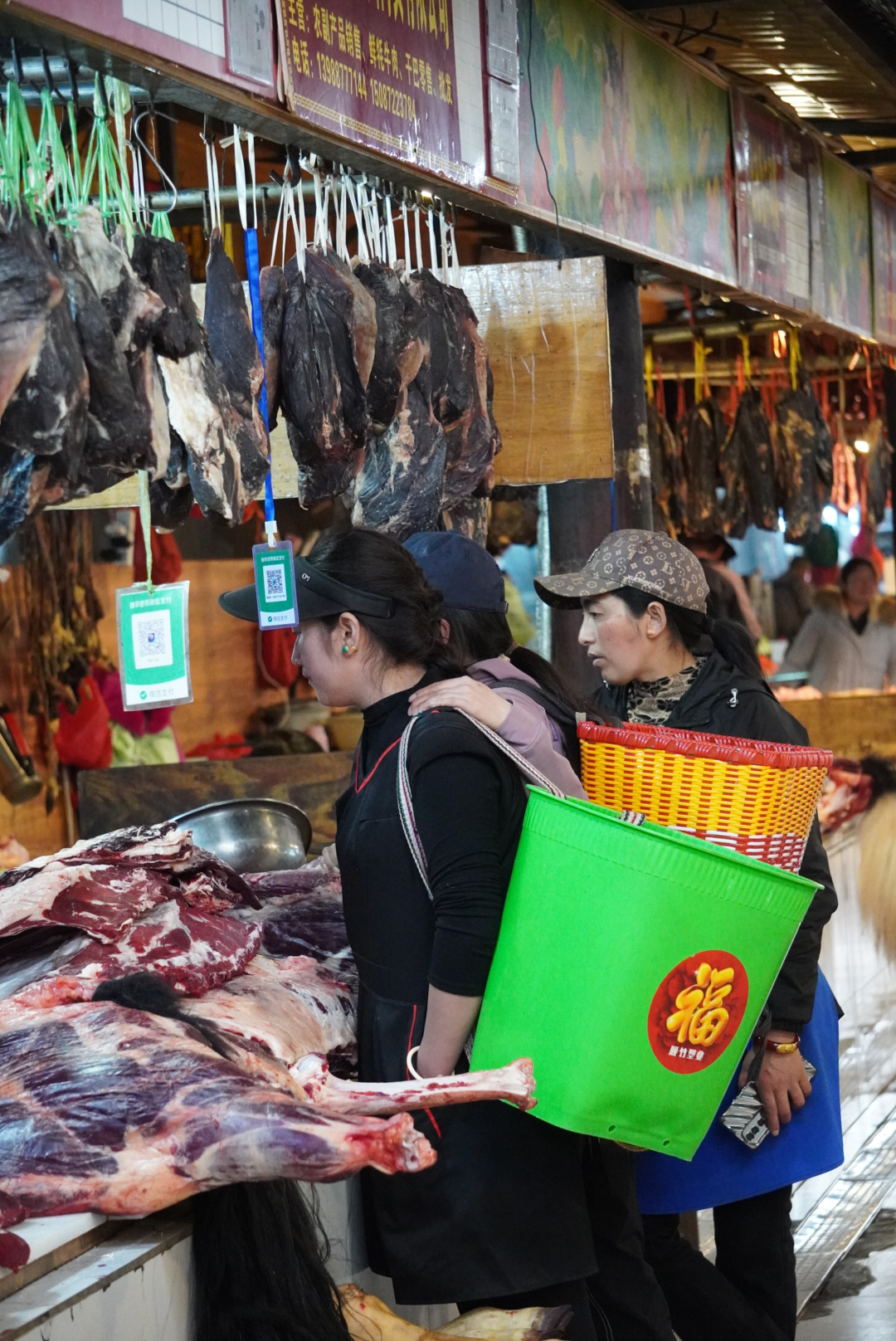Life’s flavors reside in everyday bustle
As the director of the acclaimed documentary “A Bite of China” famously remarked, “The best way to understand a city is to visit its wet markets.” Stepping into one in an unfamiliar city offers an immediate immersion: you can observe unfamiliar produce, absorb the lively local dialects, and experience unadorned daily customs firsthand. It is within the wet market, teeming with the raw aromas of life, that a city’s most authentic character and culture truly coalesce.
Wet markets are experiencing a remarkable evolution, becoming sought-after tourist attractions. Wandering through these vibrant spaces, visitors are immersed in the lively atmosphere of daily life, exploring the unique charm hidden in every nook. Some pause to indulge in traditional handmade delicacies, tasting a truly authentic flavor. Others are captivated by the warm, simple smiles of the stall owners, striking up friendly conversations and listening to the personal narratives woven into their livelihoods. Far from just a source of daily provisions, the wet market is now revealing itself as a distinctive urban landmark, offering a profound glimpse into a city’s very soul.
Kunming: A taste of the wild
During spring and summer, the abundant arrival of wild mountain vegetables and edible flowers transforms Wuliduo Farmers’ Market in Guandu District, Kunming City, into a bustling destination. This 24,000-square-meter market attracts over 40,000 daily visitors, a number that swells to over 60,000 on weekends.

Wuliduo Farmers’ Market
The Wuliduo Farmers’ Market is celebrated far and wide for its vast selection of goods and affordable prices, making it a favorite destination for locals to purchase fresh spring produce. Beyond residents, it also attracts international visitors seeking an authentic experience, transforming a market visit into a unique way to immerse themselves in Yunnan’s vibrant local life.
“Today, I brought 27 Malaysian tourists here for a ‘Yunnan life lesson,’” explained Wu Lijun, the head of the tour group. “They were captivated, snapping photos of eleuthero and broom, truly marveling at how this market felt like a botanical garden.” Nearby, at a stall dedicated to wild mountain vegetables, tourists clustered around vendor Li Hongquan, eager to learn about the diverse wild greens. Li shared, “We currently offer over 10 types of seasonal produce, with popular items like water nigella and eleuthero selling hundreds of catties daily. We also have more than 30 other wild vegetables ready to be stocked, bringing our total to 50 to 60 varieties of wild mountain vegetables for sale.”
Local food enthusiasts are equally eager to purchase. “Fried eggs with eleuthero is a spring delicacy Kunming locals must eat every year,” said Mr. Guo, a local resident, smiling as he held a bag of freshly bought tender flower buds.
“More than 10 vendors in our market specialize in selling various wild mountain vegetables and edible flowers. Floral dishes like eleuthero, birchleaf pear, and davidia flowers are very popular among residents,” introduced Li Xuanfeng, who is in charge of the market management. He added that the daily market supply of wild vegetables has recently increased, and prices are continuously dropping, attracting citizens to purchase them.
Through its direct sourcing model, Wuliduo Agricultural Expo Plaza makes wild mountain and field delicacies accessible to ordinary households. The market currently features over 10 specialized vendors, collectively providing a broad spectrum of wild vegetables, ranging from popular options at 5 yuan per bunch to premium varieties over 100 yuan per kilogram.
Furthermore, markets such as Kunming Daguan Zhuanxin Farmers’ Market, Yunnan Mushuihua Wild Mushroom Trading Center, and Donghua Farmers’ Market have all transformed into vibrant “attractions” for tourists. This increased visitor traffic has also prompted significant aesthetic improvements across Kunming’s various wet markets. Stalls are now meticulously organized into distinct functional zones for vegetables, meats, aquatic products, and more, consistently maintaining a high standard of cleanliness and tidiness. Remarkably, some even introduce innovative new business formats, like bookstores and post offices, enhancing their unique charm.
Opened in April this year, the Kunming Zhuanxin-Dianchi Wet Market immediately captivates visitors with its distinctive architectural design, featuring red brick walls, green paint, and grey tile roofs. Adding to its nostalgic charm, shops named after prominent historical establishments such as Fuchun Groceries, North Gate Grain Store, East City Restaurant, and Jianshe Road Cinema offer an immersive glimpse into old Kunming. Beyond traditional sections for meat, eggs, fruits, and vegetables, the market also houses a Qilin Bookstore and a Caijiezi Post Office. The bookstore boasts over 3,000 books sold at “wet market prices,” alongside a collection of vintage objects, antique decorations, and cultural and creative products, including artisanal ice cream and “Yunnan Goodies” series postcards. A tourist who had made a special trip to this unique destination enthusiastically remarked, “At this market, you can not only buy groceries but also enjoy a good book – truly satisfying for both your stomach and spirit.”
Rooted in the vibrancy of market life, this cultural encounter is transforming traditional farmers’ markets into dynamic showcases of Yunnan’s unique way of life. When Malaysian tourists bargain with vendors, clutching an assortment of wild vegetables, the distinct flavors and lifestyle of Yunnan truly come alive.
Dali: Discovering history’s rhythm
At 5 PM, the market at the Longwei Pass intersection in Dali City, Dali Bai Autonomous Prefecture, bursts with life, reaching its most vibrant peak of the day. Freshly picked roses are piled into fragrant hills, and tender green bok choy in bamboo baskets still carries the earthy scent of the soil. “My homemade braised meat is perfectly seasoned and tastes best with rice!” shouted a vendor in an indigo apron, speaking in authentic Bai dialect, as she lifted the lid of her pot. The rich aroma of braised meat immediately permeated the air, mingling with the char-grilled scent of roasted tofu from the street corner, compelling passersby to frequently pause.

A new couple have photos at Longwei Pass, an ancient pass built a millennium ago.
Beneath its unassuming facade, this vegetable market is rapidly emerging as a popular spot for young people. “I never expected Dali’s most unique and well-preserved street district to be here,” exclaimed a girl, camera poised, as she directed her lens towards Longwei Pass. She photographed the mottled city walls, vendors with their bamboo baskets, and young people hauling water buckets, vividly capturing the subtle, vibrant pulse of daily life that seemed to rise from the bluestone pavements.
Nestled on the north bank of the Xi’er River within Dali City’s Guanyi Community, Taihe Sub-district, Longwei Pass is an ancient pass, built a millennium ago. It once stood as a vital defensive barrier during the Nanzhao Kingdom and a strategic chokepoint on the Tea Horse Road. Today, Longwei Pass offers a vibrant juxtaposition: seasonal fruits and vegetables spill onto pavements beside hand-brewed coffee shops, while traditional barber shops directly face trendy teahouses across the street. This is where a thousand years of historical legacy beautifully intertwines with contemporary life, crafting a truly unique tapestry of local street scenes.
Ascending the bluestone path beyond the market, the rhythmic “whir” of old-fashioned sewing machines emanates from tailor shops tucked into the alleys. On the stone steps at a corner, a Yi ethnic grandmother, dressed in traditional attire, meticulously embroiders shoe insoles, colorful threads weaving intricate patterns through her nimble fingers. In front of the ancient city gate, newlyweds, guided by their photographer, subtly adjust their poses, endeavoring to capture the profound weight of history alongside the tender sweetness of their love in a single frame.
Longwei Pass has seen significant evolution in recent years; it now draws more visitors and pulsates with increased vitality, all while holding onto its ancient street charm. Luo Gang, 82, a lifelong resident, has dedicated years to preserving the ancient Longwei Street. Though mobility issues led him to move from the street a few years ago, his bond with Longwei Pass remains unbroken. Regularly, he returns, cane in hand, to stroll, greet neighbors, enjoy nostalgic meals, and recount tales of the old street to visitors.
“Comprising one pass, two streets, and sixteen alleys, Longwei Pass once stood as Dali’s crucial defensive gateway,” Luo Gang elaborated. “It flourished as a vibrant nexus where merchants from all directions traded goods and shared cultures.” Trailing Luo’s steps, visitors journey through the ancient streets, winding alleys, beside age-old wells, and beneath the city gates, watching Longwei Pass’s history spring to life. Luo pointed out that most of Longwei Pass’s historic residences, built from timber and earth or brick, remain remarkably intact in their traditional “three compounds and one screen wall” or “quadrangle with five patios” layouts. “Our efforts to protect Longwei Ancient Street involved renovating numerous old buildings,” Luo said, sweeping his hand towards the street’s bustling businesses. “This preservation has, in turn, attracted a wave of new enterprises.”
Guided by Luo, our reporters rounded Longwei Pass’s arched gateway, where Old Tang’s Coffee Shop emerged, a rich aroma instantly enveloping them. What was once an old courtyard had been lovingly renovated and reborn as this inviting coffee haven. The owner, 51-year-old Tang, originally from Dalian, Liaoning, has made Dali his home for 11 years. As he meticulously ground coffee beans, he said enthusiastically, “Our shop boasts over 200 varieties of coffee beans. Every single cup is carefully brewed, reflecting our deep passion for both coffee and life itself.”
“I was initially concerned a coffee shop might feel out of place in such a historic setting,” Tang confessed. “But to my astonishment, the neighbors not only accepted it but eagerly embraced my hand-brewed coffee.” This vibrant interplay of old and new defines Longwei Pass: venerable houses are reborn as artistic tea houses, and traditional courtyards are transformed into inviting guesthouses... Here, history and contemporary life meet, forging a truly distinctive brilliance.
The allure of Longwei Pass’s transformation extends to its younger residents. Wang Zhouzhou, 27, who moved to the area two years ago, makes a regular pilgrimage to the ancient well for water. “The daily spectacle of people fetching water, riding bicycles or pulling small carts across Heilong Bridge, is particularly vibrant and full of life,” Wang observed. She added that Longwei Pass’s captivating essence lies in its harmonious convergence of nature, history, and everyday living. Her path to the well unfolds a series of vivid scenes: bustling vegetable markets, taverns overflowing with wisteria blooms, intricate handmade embroidery stalls, and ancient mud walls telling historical tales. These direct, tangible experiences make history not just visible, but profoundly comprehensible.
As night descends and the last vegetable stalls are cleared away, Longwei Pass gradually settles into a profound quiet. This thousand-year-old ancient pass serves as both a cherished repository of nostalgia for “old Xiaguan” residents and a sought-after lifestyle for new Dali residents. As Luo put it, “Longwei Pass is not a contrived tourist destination, but a place where genuine life is lived.”
Pu’er: Exploring local delights along the Nanlang River
As evening falls, twilight gently blankets the Nanlang River. Along its banks, within Pu’er City’s Lancang Lahu Autonomous County, the over 1,000-meter-long Lancang Street gradually stirs to life, its entire length soon aglow with bright lights.

A busy market in Pu'er
Featuring an abundant array of fresh vegetables and fruits, savory wild mountain greens, and rare delicacies like wasp pupae and edible insects, Lancang Street is a beloved spot for locals and those from nearby counties. It also attracts countless tourists who travel from afar specifically to experience the market’s vibrant and unique ethnic minority atmosphere.
“Local mini corn, freshly charcoal-grilled, two for 5 yuan!” called out the vendor, a man nearing fifty, from behind his grilled corn stall. With practiced hands, he tirelessly turned corn, sweet potatoes, and potatoes over the glowing charcoal. The instant a passerby hesitated, he would pivot, launching into an enthusiastic sales pitch.
These unassuming stalls are the key to Lancang Street’s lasting vibrancy. Particularly on Saturday evenings, farmers from surrounding villages arrive under the cover of night to establish their temporary shops, filling the market with a dazzling array of mountain produce that beautifully captures the essence of local rural life.
With Lancang Street’s surging popularity, the existing market setup along the county’s main thoroughfare became insufficient to meet escalating demand. In response, in 2019, the Lancang County government attracted investment to comprehensively plan the Nanlang River’s western section. This project led to the relocation of the entire Lancang Street market and the establishment of Lahu Town, creating a modern street night market. This new street now functions as a dynamic cultural tourism hub, expertly weaving together Lahu cultural promotion, a vibrant creative industries scene, and popular contemporary trends.
Lancang Street today offers more than just mountain produce; it presents a panoramic spectacle of rich ethnic customs. It has shed its former weekend-only vibrancy, now thriving as a unique market bustling with activity and life daily. Stalls line the street in an endless procession, wisps of cooking smoke rise, and the sounds of music and vendors’ calls blend into a delightful chorus. The air, thick with the irresistible scents of grilling food and fresh fruits, frequently lures passersby to pause. Brightly lit shops along the street warmly beckon customers inside. In their parents’ arms, children curiously observe this vibrant world, their eyes wide with wonder.
Lancang Street’s success has also catalyzed the development of neighboring cultural and entertainment facilities. Along its vibrant thoroughfare, specialty coffee shops and creative cultural stores now abound. Here, visitors can not only savor authentic local delicacies but also discover unique ethnic cultures and witness the dynamic interplay between creativity and modern trends. Tradition and modernity seamlessly merge in this space, as ancient ethnic cultures radiate renewed vitality in this new era, drawing increasing numbers to explore its distinctive allure.
Shangri-La: Embracing the poetic spirit of plateau living
Even before full dawn, the iron gates of Xiangyang Farmers’ Market in Shangri-La City, Diqing Zang Autonomous Prefecture, are already flung wide. Elderly Zang ladies, their backs laden with bamboo baskets, meticulously arrange freshly made milk dregs on wooden stalls. Lisu young men stride past purposefully, shouldering gleaming black pottery jars. Naxi vendors, their Mandarin bright with local accents, enthusiastically present prized morel mushrooms and matsutake to curious tourists. Within this bustling market, affectionately known to locals as “Golden Bridge,” a new day’s narrative begins to unfold as the plateau’s nascent morning light pierces the ethereal mist rising from the tin roof.

A busy market in Shangri-La
In the Zang language, “Shangri-La” translates to “sun and moon in the heart.” This profound meaning is vividly reflected in the Xiangyang Farmers’ Market, a dynamic hub that mirrors both the rugged essence and generous spirit of plateau life. Far more than just a place for locals to acquire daily necessities, it functions as a vibrant window into the region’s rich ethnic cultures and daily routines. Here, people from various ethnic groups—Zang, Naxi, Bai, and others—converge, their distinct languages, colorful attire, and unique wares intertwining to create a living, breathing tapestry of cultural exchange.
In the bustling vegetable section, the spirited cries of an elderly Bai woman resonate clearly: “Dali greens, 3 yuan! No bargaining!” When a tourist inquires, she confidently grasps a handful of fresh greens, urging, “Smell this earthy freshness! They just came from Erhai Lake this morning.” At a market perched at an altitude of 3300 meters, most vegetables are transported long distances, making potatoes one of the few true “local produce.” Vegetable vendor Wang Jianjun chuckles as he shares a culinary tip: “Shangri-La potatoes are firmer than those from Dali; to truly absorb the flavor when stewing them in soup, you have to break them apart.”
At the wild vegetable stall, an elderly Zang woman named Gesang eagerly intercepts a tourist about to leave. She patiently demonstrates by snapping a piece of swamp cabbage: “If you don’t pinch off the heart, it’ll be so bitter you’ll jump!” Even though wild mountain vegetables, gathered when the snow first melts, command a good price, she generously scoops two handfuls into the tourist’s basket, saying: “These are extra for you, welcome back next time.” This warmth and generosity are a true reflection of the plateau people’s character.
“The lamb offal soup won’t be ready until the afternoon; for now, we only have lamb’s head meat,” explained the boss, known as Fourth Brother, as he crouched by the coal stove, stirring the embers with an iron hook. At the deep-fried snack stall, 65-year-old Zang lady Yangzom has been a steadfast presence for 23 years. Eight coal stoves have come and gone, witnessing her dedicated years, yet the price of her cold jelly noodles remains unchanged at 5 yuan a serving—a tangible expression of her enduring goodwill toward her loyal, long-time customers.
At the bustling butcher and medicinal herb stalls, the interactions between buyers and sellers brim with wisdom and humor. To demonstrate the quality of his yak meat, stall owner Losang flips open a tent flap, revealing the intricate marbling. Nearby, medicinal herb vendor Azhimu snaps open a fritillary bulb, its bitter cross-section swiftly dispelling any tourist’s doubts. These daily exchanges are far more than mere commerce; they are a vibrant conduit for culture and trust.
Text by our staff correspondents
Translated by YNTA
Proofreading by Zu Hongbing